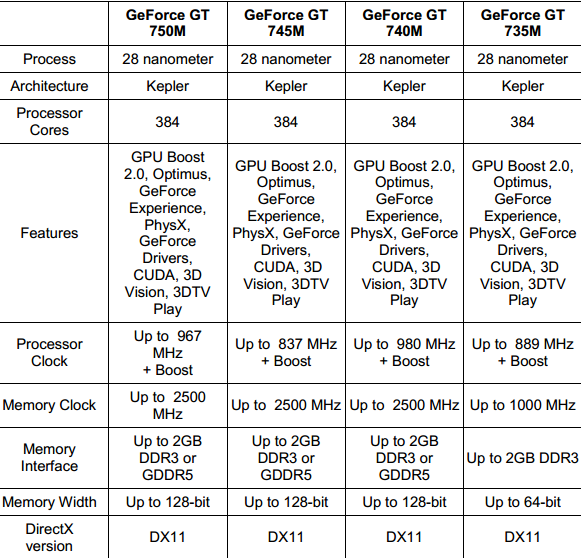NVIDIA Launches GeForce 700M Mobile GPUs with Higher Clocks, Better Power Management
Better Boosting:
When NVIDIA launched the GeForce GTX Titan in February, it discussed a new iteration of GPU Boost technology that measured GPU temperature rather than estimating TDP. This new approach gave NVIDIA finer-grained control over clock speeds and thermal thresholds, thereby allowing for better dynamic overclocking.
That technology is coming to the GeForce 700M mobile family. In notebooks, GPU Boost 2.0 is a combination of thermal and application monitoring. The thermal monitoring is straightforward -- the chip watches system temperatures to make decisions about when it can increase clocks and how much it can afford to do so. Application monitoring is a bit different.
GPU Boost 2.0 is designed to reflect an important fact of 3D gaming -- no two applications use the same amount of power. The variance can be significant, even within the same game. It's therefore possible for the GPU to adjust clocks dynamically in order to maximize frame rates.

Put the two together, and NVIDIA believes it can substantially improve FPS speeds without compromising thermals or electrical safe operating margins.
The major push from NVIDIA, of course, is that Ivy Bridge's graphics "continue to frustrate." Haswell is set to challenge these figures in the not-too-distant future; mobile CPUs with the "GT3" graphics core from Intel will include up to 40 compute units (Ivy Bridge tops out at 16) and possibly on-package memory as well.
The New SKUs:
Here's the differences between the 600M and 700M families, broken down by SKU:

The GeForce GT 750M and 745M are rebranded GT 645M and GT 650M parts with higher boost clocks and RAM frequencies. Both of these cards support DDR3 and GDDR5; total memory bandwidth will depend on which RAM type the card uses. GPU Boost 2.0 should improve performance modestly when compared against their predecessors.
The GT 740M is clocked significantly faster than the GT 640M, (980MHz vs 625MHz), but has less RAM bandwidth (a max of 40GBps compared to the GT 640M's 64GBps).
Unfortunately, the rest of the cards may not be much of an upgrade. The GT 735M is based on Kepler, whereas GT 635M was a Fermi product. It's built on 28nm technology rather than the older 40nm. GT 735M's clock speed is much higher (889MHz + Boost compared to 675MHz). Memory bandwidth, though, has fallen like a rock.
The GT 635M had a 128-bit or 192-bit bus with 28.8 - 43.2GBps of total memory bandwidth. The GT 735M, in contrast, has a 64-bit bus and can't use high-speed GDDR5. As a result, its max memory bandwidth is just 16GBps -- 57% as much as the GT 635 offers.

The new GT 730M has a similar problem. The GT 630M was a Fermi-derived core with a 128-bit or 64-bit memory bus and support for DDR3 and GDDR5. The GT 730M is 64-bit, DDR3-only. That's in contrast to when the GPU was first announced in January -- back then, it supposedly had a 128-bit memory bus. We've reached out to NVIDIA for confirmation of this change but the company hasn't gotten back to us as of this writing.
Will it matter? Our gut says yes. Kepler is a more efficient architecture than Fermi, but it's not efficient enough to slash memory bandwidth nearly in half without an impact on performance. NVIDIA hasn't released any performance figures that show the new GT 700M cards against their 600M counterparts and that's not exactly a mark in their favor.
The Bottom Line:
The GT 730M and 735M aren't rebadged GT 600M parts, but they may actually be slower than the cards they are replacing. The GT 740M and 750M are rebadged GT 640/650 cards with higher core clocks and GPU Boost, but less memory bandwidth as well.
It's good to see NVIDIA's entire product stack on 28nm and we're glad that GPU Boost 2.0 is now supported on all the company's GT 700M products. We'd be happier, however, if the Kepler parts were all upgrades from their Fermi predecessors. Right now, it's simply not clear whether or not that's true. The 630/635M's both supported GDDR5; the 730/735M don't.
NVIDIA took time to crow over crowding AMD out of the discrete market (a fact that's born up by independent research), but Haswell is the bigger threat. Intel's next-generation processor could improve on Ivy Bridge's performance by 50% or more -- and that's a big enough jump to threaten both NVIDIA and AMD.

